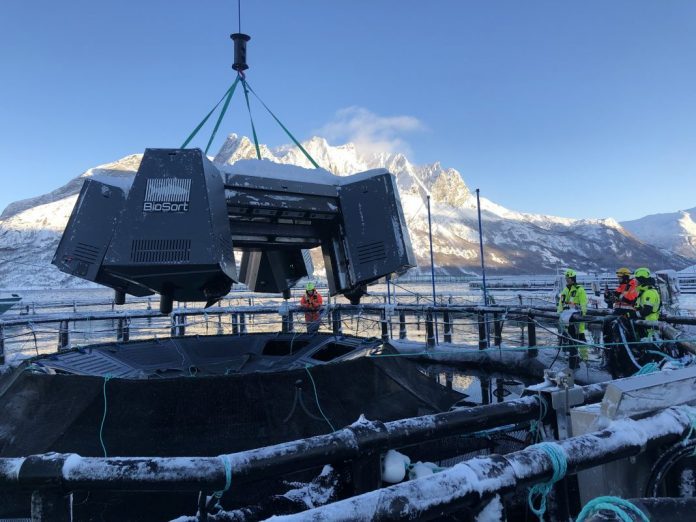The camera sensor that will recognise each fish in iFarm is in place. The goal is for better fish health and welfare with the help of artificial intelligence.
Cermaq will use artificial intelligence and machine learning to identify each salmon in a fish farm. When each fish can obtain its own health record and adapted follow-up, fish health and welfare is ensured. Now the first version of the iFarm sensor will eventually detect and recognise each fish in the cage.
The iFarm project, one of the aquaculture industry’s most exciting technology projects, is a collaboration between Cermaq, the technology company BioSort, and ScaleAQ, which is the equipment supplier to the project.

Interaction
iFarm is not easy to spot. Most of the components of the system are located below the sea surface, down in the cage, and interact with the salmon’s movement pattern. The salmon are fed under a net roof deep in the cage. When swimming to the surface to breathe and fill the swimming bladder, it must swim through a narrow section. This is where the iFarm sensor is now located, and this is where Cermaq will be able to record and eventually identify each fish.
“The fish we put out in the iFarm fields in September last year have eaten well and seem to thrive and swim easily up and down through the passage in the net-roof to get to the surface. When we were about to put out the camera sensor, we were of course very excited about how the fish would react,” iFarm Cermaq’s project manager Karl Fredrik Ottem said in a press release.
With the camera sensor in place in the cage, fish narrowed through the passage significantly when swimming up to the surface. The fact that the interaction between the fish and the sensor system works well is essential for the next phases of the project.
“With the camera sensor in place, we will start testing how the camera and light work at a depth of six metres. There is talk of extremely advanced technology that is now located down in the cage, and that will interact with the fish,” said Ottem.

Monitor
Chris Noble, an expert in fish welfare and a senior researcher at Nofima, has been following the iFarm project closely, confirming that fish behaviour is a key.
“To document and monitor how iFarm installations affect fish, the project takes a step-by-step approach and adds or improves one component at a time. The fish are monitored before and after the change using a number of operational welfare indicators, especially fish behaviour in and around the iFarm sensor. Incremental modifications mean that the project partners get a good overview of the impact of each change, and can use the findings to make adjustments to the next steps of the project,” said Noble.
The 11 cameras placed inside the sensor will scan each fish and will be able to capture and recognise small details, such as sea lice and the spot patterns on salmon. And that is on a fish that is moving all the time. This will make it essential to achieve good lighting and good quality images.
“In addition to monitoring the behaviour and welfare of the fish, we will now also test electronics and software, operational stability and functionality, and light and camera underwater. So far most things have gone very well, but with the camera sensor in the sea, we are now increasing the difficulty level significantly. This is where we are in the real new work, so going forward now it will be very exciting,” said Ottem.


